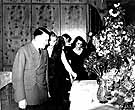
|
|
|

|

|

|

|
|
Click on an image to see a larger, more detailed picture.
|
|
|
|
|
| 1942: The "Final Solution" |

|
pg. 313 |

|
|
|
|
| |
 On April 3, 1942, 1200 Jews were deported from the Ukrainian town of Tlumacz to the death camp at Belzec, which began operation the previous month. They were among the approximately 600,000 Jews, most of them from Poland, who died in Belzec in 1942. Here the Jews are being assembled for deportation.
On April 3, 1942, 1200 Jews were deported from the Ukrainian town of Tlumacz to the death camp at Belzec, which began operation the previous month. They were among the approximately 600,000 Jews, most of them from Poland, who died in Belzec in 1942. Here the Jews are being assembled for deportation.
|
 With his mistress, Eva Braun, at his side, the Führer admires the flowers and gifts presented in celebration of his 53rd birthday on April 20, 1942. Hitler enjoyed his birthday at his retreat, the Berghof in Berchtesgaden, surrounded by the Bavarian Alps. Secretive about Eva's presence in his life and disdainful of her girlish tastes, Hitler nonetheless enjoyed the sense of home and comfort she provided. She played hostess at countless tea parties and evening gatherings of his inner circle.
With his mistress, Eva Braun, at his side, the Führer admires the flowers and gifts presented in celebration of his 53rd birthday on April 20, 1942. Hitler enjoyed his birthday at his retreat, the Berghof in Berchtesgaden, surrounded by the Bavarian Alps. Secretive about Eva's presence in his life and disdainful of her girlish tastes, Hitler nonetheless enjoyed the sense of home and comfort she provided. She played hostess at countless tea parties and evening gatherings of his inner circle.
Photo: SYddeutscher Verlag Bilderdienst
|
 Edith Stein
Edith Stein
Edith Stein used her faith and intellect to become a thorn in the side of the Third Reich. A German Jew who earned a doctorate in philosophy, she converted to Catholicism in 1922. Following a decade of teaching and writing, Stein was appointed to lecture at the German Institute for Scientific Pedagogy in 1932. She wrote to Pope Pius XI, asking him to issue an encyclical condemning Nazi racism. She was dismissed a year later because her parents were Jewish. Shortly after, Stein relocated to Cologne, Germany, and became Sister Teresia Benedicta, a Carmelite nun. While at a convent in the Netherlands in 1942, Stein was arrested by the Gestapo. She was deported to Auschwitz, where she comforted many inmates. She was gassed there on August 8, 1942, ostensibly in retaliation for the anti-Nazi activities of Dutch Catholic bishops. Stein was recognized as a saint by the Roman Catholic Church in 1998. A chapel stands in her honor at Auschwitz.
Photo: Rijksinstituut voor Oorlogsdocumentatie / United States Holocaust Memorial Museum Photo Archive
|
|

|

|

|

|
 April 3, 1942: This day's deportations from Augsburg, Germany, empty the town of Jews, ending a Jewish presence that was established in 1212. They are deported to the Belzec death camp.
April 3, 1942: This day's deportations from Augsburg, Germany, empty the town of Jews, ending a Jewish presence that was established in 1212. They are deported to the Belzec death camp.
|
 April 5, 1942: The Lutheran Church of Norway issues "Kirken grunn" ("Foundations of the Church"), a letter condemning Nazism and racism and protesting efforts of Vidkun Quisling, Norway's German puppet, to "nazify" Norway's churches.
April 5, 1942: The Lutheran Church of Norway issues "Kirken grunn" ("Foundations of the Church"), a letter condemning Nazism and racism and protesting efforts of Vidkun Quisling, Norway's German puppet, to "nazify" Norway's churches.
|
 April 11, 1942: A German proclamation issued in Lvov, Ukraine, excoriates Polish civilians who assist Jews.
April 11, 1942: A German proclamation issued in Lvov, Ukraine, excoriates Polish civilians who assist Jews.
|
 April 11, 1942: Three thousand Jews from Zamosc, Poland, are deported to the Belzec death camp.
April 11, 1942: Three thousand Jews from Zamosc, Poland, are deported to the Belzec death camp.
|
 April 16, 1942: SS officials in the Ukraine inform authorities in Berlin that the Crimea is judenrein (purged of Jews).
April 16, 1942: SS officials in the Ukraine inform authorities in Berlin that the Crimea is judenrein (purged of Jews).
|
 April 17, 1942: The Nazi government decrees that apartments occupied by Jews in Greater Germany must be identified as such.
April 17, 1942: The Nazi government decrees that apartments occupied by Jews in Greater Germany must be identified as such.
|
|
|
|
|
| 1942: The "Final Solution" |

|
pg. 313 |

|
|
The Holocaust Chronicle
© 2009 Publications International, Ltd.
|
|
